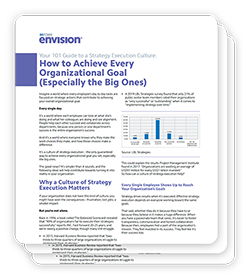
Is it Time to Refresh Your Strategy?
October 20, 2020
Strategic Improvisation – See Execution Happen Using The Seven C’s
November 9, 2020Is Your Strategy Planning Process Outdated?

It is said that strategy planning is ‘old school,’ that the very nature of committing to a plan for the long term doesn’t allow organizations to be responsive, flexible, or agile enough to move with today’s current marketplace.
Further, it’s said the act of doing strategic plans are for slow moving managers, not high-performing leaders. We’re here to argue that’s not the case.
It’s almost framed up as though, “We’re in the business of being responsive to the marketplace and planning isn’t cool because it doesn’t allow us to have our finger on the pulse of the future.” The fallacy of this argument is inherent in the nature of plans, which are directly reflective of each organization’s culture and leadership. If the organizational culture is unresponsive and inflexible, the plans will be written and administered that way. On the other hand, if leadership has fostered a culture of adaptability, agility and speed, their strategic planning will naturally reflect this flexible approach.
Organizational Strategy and Leadership
To say strategy planning as a whole is no longer necessary is extreme for the sake of being extreme. It’s a good headline, perhaps, but if you dig deeper it doesn’t make sense. The only reason to stop doing planning is if you aren’t interested in communicating where you are going to the rest of your organization. Planning will always be relevant because the strategic planning process establishes a solid communication between leadership and the employees, and its outcomes drive a result that lets everyone know why they come to work every day. To say that the pace of change has accelerated too much for a plan to be necessary is to believe that change is so important that it supersedes communication.
On the contrary, in a fast-moving economy, one of the most important things you need to do is to communicate with everyone why you come to work (mission), what your non-negotiables are (values) and where you are going (vision). A team with a clear definition of what the company’s goals and values are can be more strategically agile precisely because this kind of communication has happened. Planning draws boundaries and directions and, with flexible management, allows people to operate within parameters and, as long as they remain focused on organizational goals, take risks, act on ideas and move with the marketplace.
A Strategy Plan Template? Or Flexible?
The key is to understand the end destination and the rules you’ll play by. After that, strategic plans actually allow you to be more flexible because the destination, the vehicle, and the driver are all defined. It’s then up to the organization to map out the journey, allow for roadblocks, re-directs, exits, and on-ramps. In this scenario, plans become communication vehicles that set parameters and allow for focus, efficiency, and teamwork.
There are certainly some situations where organizations don’t need a clear, compelling plan to make things work. Many times, these organizations are smaller, sometimes start-ups, driven by a charismatic leader with a team that has a uniform outlook on the future. They don’t lose sight of the shared goal because the charismatic leader is in contact with the entire team on a daily basis. Often these organizations have a single product or service that allows them to be hyper-focused on success.
This situation, however, does not mirror the majority of organizations, especially non-profits, Fortune 500’s, anyone interested in growing their business past a single product offering, or anyone hoping to sell their company one day. Most organizations more frequently have the problem of a lack of focus. In these cases, planning is critical because ‘seat of the pants’ leadership, is confusing for the organization and frustrating for employees.
Strategy Execution Accountability
So, going through the strategic planning process of planning and making decisions about the company, its culture, and its future are important tools in focusing on the organization. The key to total success from here is to implement the plan and to show everyone that you are making it happen. The worst thing leadership can do is create a plan and put it on the shelf; to use time and resources and “rally the troops” but never return to the plan to review it and hold everyone accountable. That is old-style management. That is a culture that cannot change the way it does business.
To ensure your plan is an important part of the future, make it flexible and actually execute your strategy! Create a culture of accountability throughout the organization, ensuring that everyone is behind the decisions you made and put their actions into achieving the goals the organization has set for itself.




